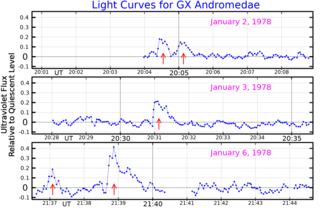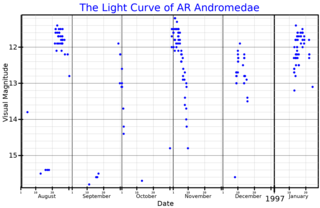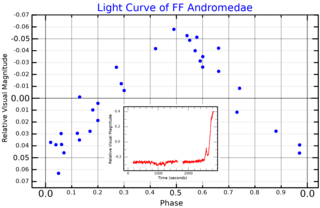EG Andromedae (often abbreviated to EG And) is a symbiotic binary in the constellation Andromeda. Its apparent visual magnitude varies between 6.97 and 7.80. [3]
EG Andromedae (often abbreviated to EG And) is a symbiotic binary in the constellation Andromeda. Its apparent visual magnitude varies between 6.97 and 7.80. [3]
The EG Andromedae system hosts a white dwarf and an evolved giant star, with an orbital period of 482 days and a half. The giant star is losing mass through its stellar wind at a rate higher than 10−6M☉/yr, and the white dwarf is accreting a fraction of this mass without forming an accretion disk. The white dwarf itself could emit a hot wind that interacts with the cooler one of the giant star, in addition to inducing the photoionization of the latter. [7] X-ray observations, however, failed to detect emission coming from colliding winds, but established the non-magnetic nature of the white dwarf and estimated its accretion rate at 1-10×10−7M☉/yr. [8]
The giant star doesn't fill its Roche lobe but there are still large uncertainties on its mass and radius. [6] Even the parameters of the white dwarf are not strictly constrained, but available models can give lower and upper limits. [7]
The optical spectral classification of EG Andromedae is M2IIIep, [3] the one of a cool giant star with a peculiar spectrum and strong emission lines. The white dwarf contaminates the spectrum of the giant star photoionizes the stellar wind, giving rise to the spectral peculiarities. Emission lines H-alpha and H-beta, as well as TiO and Ca I ones, change in phase with the orbit. [6]
The white dwarf is best studied in the ultraviolet, where also highly ionized species sulfur, oxygen, nitrogen, carbon and phosphorus can be identified with their absorption or emission lines. [7]
X-ray observation of EG Andromedae detected a hot plasma (at a temperature of 3 keV) that is likely situated in the outer boundary layer of the white dwarf, without any contribution from an accretion disk. [8]
To date, no outburst has been observed in EG Andromedae. The observed variability is well described by the two components eclipsing each other during the orbit. However, there is some evidence that the giant star and the wind flow have an intrinsic variation. [9]
HD 88133 is a yellow star with an orbiting exoplanet in the equatorial constellation of Leo. It has an apparent visual magnitude of 8.01, which is too faint to be visible to the naked eye. With a small telescope it should be easily visible. The distance to this system, as measured through parallax, is 240 light years, but it is slowly drifting closer with a radial velocity of −3.6 km/s.

Groombridge 34 is a binary star system in the northern constellation of Andromeda. It was listed as entry number 34 in A Catalogue of Circumpolar Stars, published posthumously in 1838 by British astronomer Stephen Groombridge. Based upon parallax measurements taken by the Gaia spacecraft, the system is located about 11.6 light-years from the Sun. This positions the pair among the nearest stars to the Solar System.

T Coronae Borealis, is a recurring nova in the constellation Corona Borealis. It was first discovered in outburst in 1866 by John Birmingham, although it had been observed earlier as a 10th magnitude star.

Lambda Andromedae, Latinized from λ Andromedae, is the Bayer designation for a binary star system in the northern constellation of Andromeda. At an estimated distance of approximately 84.6 light-years from Earth, it has an apparent visual magnitude of +3.8. This is bright enough to be seen with the naked eye. The system is drifting further away from the Sun with a radial velocity of +6.8 km/s.

8 Andromedae, abbreviated 8 And, is a probable triple star system in the northern constellation of Andromeda. 8 Andromedae is the Flamsteed designation. It is visible to the naked eye with an apparent visual magnitude of 4.82. Based upon an annual parallax shift of 5.7 mas, it is located about 570 light years from the Earth. It is moving closer with a heliocentric radial velocity of −8 km/s.
6 Andromedae is an astrometric binary star system in the northern constellation of Andromeda. The designation comes from the star catalogue of John Flamsteed, first published in 1712. Its apparent visual magnitude is 5.91, which is just bright enough to be visible to the naked eye under good seeing conditions. Based upon an annual parallax shift of 34.1 mas as seen from Earth, it is around 96 light years from the Sun. It is moving closer to the Sun with a radial velocity of −32.4 km/s. The system has a relatively high proper motion, advancing across the celestial sphere at the rate of 0.272 arc seconds per annum.
Z Andromedae is a binary star system consisting of a red giant and a white dwarf. It is the prototype of a type of cataclysmic variable star known as symbiotic variable stars or simply Z Andromedae variables. The brightness of those stars vary over time, showing a quiescent, more stable phase and then an active one with a more pronounced variability and stronger brightening and/or dimming.

R Aquarii is a variable star in the constellation Aquarius.

A symbiotic binary is a type of binary star system, often simply called a symbiotic star. They usually contain a white dwarf with a companion red giant. The cool giant star loses material via Roche lobe overflow or through its stellar wind, which flows onto the hot compact star, usually via an accretion disk.

RX Andromedae is a variable star in the constellation of Andromeda. Although it is classified as a dwarf nova of the Z Camelopardalis (UGZ) type, it has shown low-luminosity periods typical of VY Sculptoris stars. However, for most of the time it varies from an apparent visual magnitude of 15.1 at minimum brightness to a magnitude of 10.2 at maximum brightness, with a period of approximately 13 days.
HD 16760 is a binary star system approximately 227 light-years away in the constellation Perseus. The primary star HD 16760 is a G-type main sequence star similar to the Sun. The secondary, HIP 12635 is 1.521 magnitudes fainter and located at a separation of 14.6 arcseconds from the primary, corresponding to a physical separation of at least 660 AU. Announced in July 2009, HD 16760 has been confirmed to have a red dwarf orbiting it, formerly thought to be a brown dwarf or exoplanet.

56 Pegasi is a binary star system in the northern constellation of Pegasus. It is visible to the naked eye with a combined apparent visual magnitude of 4.74. The system is approximately 590 light years away from the Sun based on parallax, but is drifting closer with a radial velocity of −28 km/s. It is listed as a member of the Wolf 630 moving group.

AG Pegasi is a symbiotic binary star in the constellation Pegasus. It is a close binary composed of a red giant and white dwarf, estimated to be around 2.5 and 0.6 times the mass of the Sun respectively. It is classified as a symbiotic nova; it has undergone one extremely slow nova outburst and a smaller outburst.

DD Microscopii, also known as CD−43°14304, is a binary star system in the constellation Microscopium. The system has a combined average apparent magnitude around 11, making it readily visible in telescopes but not to the naked eye. It is thought to be at a distance of one or two thousand parsecs, although parallax measurements place the system at a distance of around 30,000 light years.

CH Cygni is a red giant, variable, symbiotic binary in the constellation Cygnus. It is the nearest symbiotic star to Earth, and one of the brightest, making it an ideal candidate for study.

AR Andromedae is a dwarf nova of the SS Cygni type in the constellation Andromeda. Its typical apparent visual magnitude is 17.6, but increases up to 11.0 magnitude during outbursts. The outbursts occur approximately every 23 days.

FF Andromedae is a spectroscopic binary in the constellation Andromeda. It has a typical apparent visual magnitude of 10.4, but undergoes flare events that can increase its brightness by about a magnitude.

PX Andromedae is an eclipsing cataclysmic variable star in the constellation Andromeda. It has been classified as a SW Sextantis variable, and its apparent visual magnitude varies between 14.04 and 17.

V455 Andromedae is a dwarf nova in the constellation Andromeda. It has a typical apparent visual magnitude of 16.5, but reached a magnitude of 8.5 during the only observed outburst.

4 Draconis, also known as HR 4765 and CQ Draconis, is a star about 570 light years from the Earth, in the constellation Draco. It is a 5th magnitude star, so it will be faintly visible to the naked eye of an observer far from city lights. It is a variable star, whose brightness varies slightly from 4.90 to 5.12 over a period of 4.66 years.